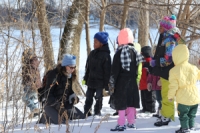Often during the winter we spend a little more time inside, but we always make sure to explore and stretch our legs, even in the cold. Sometimes this is the only real outside time our students get all week.
During a recent field trip with a second grade class, the teacher told me that they had been having indoor recess for months, and hadn’t had gym class either. During the inside activities about the water cycle, the students were enthusiastic, but once we got outside they were unable to contain their energy. They were practically vibrating, and I knew that the planned activities for our hike weren’t going to happen the way I thought.
It was an optimistic, 40-degree day. The maple sap was flowing and the ice covering most of Washington Park was breaking up. Channels of water were rushing downhill through ravines of mud and slush. The students immediately rushed over to these “rivers,” shouting and splashing. Some wanted to follow the river uphill, while others started tossing leaves in and watching them race away. Several students started constructing a small dam out of sticks and rocks, and all at once the entire class was working together to alter the rushing water with chunks of snow, fallen branches and even goose scat. The teacher and I simply sat by answering questions and providing encouragement here and there, but mostly we just watched as the class explored the concept of water on their own. Not only were they learning about the planned topic of the class, they were practicing engineering, cooperation and creativity. It was exactly the sort of outdoor play time we strive to encourage on each trip to the Urban Ecology Center, but I had never seen it more alive. I couldn’t have planned a better trip or activity than the one the students came up with on their own, at the sight of ice melting on a sidewalk. They were breaking free of winter, entering a state of pure, exuberant springtime.
Photo credit: Chris Von Briesen





